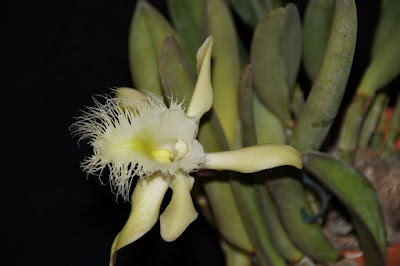Rhyncholaelia digbyana meet in the south-eastern Mexican states of Yucatan and Quintana Roo, and their range extends across the Belize lowlands lying on the Caribbean side to Honduras. They grow on stunted trees in the hot, humid lowlands, almost at sea level...
Rhyncholaelia digbyana also called as Digby's Beaked Laelia, Bletia digbiyana, Brassavola digbyana, Brassavola digbyana f. fimbripetala, Brassavola digbyana var fimbripetala, Cattleya digbyana, Laelia digbyana, Laelia digbyana var fimbripetala, Rhyncholaelia digbyanan f. fimbripetala, is a species of the genus Rhyncholaelia. This species was described by Rudolf Schlechter in 1918.
IDENTIFY RHYNCHOLAELIA DIGBYANA
Rhyncholaelia digbyana meet in the south-eastern Mexican states of Yucatan and Quintana Roo, and their range extends across the Belize lowlands lying on the Caribbean side to Honduras. They grow on stunted trees in the hot, humid lowlands, almost at sea level.
It is a hot to warm growing, medium to large sized, epiphytic plant, which reaching a height up to 35 cm, with 15 cm, elongate, compressed, closely spaced pseudobulbs with a single axillary, elliptic, erect, stiff, fleshy, 20 cm leaf.
Digby's Beaked Laelia is glaucous, and the terminal, erect, 7.5 cm long inflorescence subtended by a large sheath, bears a single large, lemon scented, flower that appears in the summer. The shiny, pale, yellowish-green flowers have a diameter of almost 18 cm. They are extremely fragrant, especially at night, durable and have a very distinctive texture with a waxy sheen. The very large lip is slightly 3-lobed and forms a wide-spread tube around the spine, and its outer edges are deeply curled and nicked. It usually has a cream-white color, but it is slightly colored green, and its throat is often colored in emerald color.
RHYNCHOLAELIA DIGBYANA CARE AND CULTURE
Cultural information should only be used as a guide, and should be to be adapted to suit you. Your physical location; where you grow your plants, how much time you have to devote to their care, and many other factors, will need to be taken into account. Only then can you decide on the cultural methods that best suit you and your plants.
Light:
Rhyncholaelia digbyana needs a light level of 25000-40000 lux. The light should be bright but slightly filtered or scattered, and the plants should not be exposed directly to the sun in the afternoon hours. Strong air movement should be ensured all the time.
Temperature:
It is a thermophilic plant. The average summer temperature during the day reaches 31 ° C, at night 24 ° C, with a daily difference of 7 ° C. In winter, the average day temperature is 27-28 ° C, at night 19-21 ° C, with a daily amplitude of 7-8 ° C.
Humidity:
Digby's Beaked Laelia needs the humidity of about 80% throughout the year.
Substrate, growing media and repotting:
High demands on irrigation during the growth period require the use of a very loose, well-permeable substrate, eg pine bark, pieces of cork or tree fern fibers with medium or high gradation. Rather smaller pots should be used, so that only the roots fit and there was room for two-year increments.
Rhyncholaelia digbyana can be attached to cork or tree ferns if we can provide them with high humidity and watering at least once a day during the summer. In the case of such suspended plants, during the dry and hot periods it may be necessary to water several times a day. Repotting should be performed when new roots start growing or immediately after flowering.
Watering:
Rainfall for most of the year is moderate to intense with 2-3 months slightly drier period at the end of winter and early spring. The cultivated plants should be watered strongly during the full growth, but the roots must always dry quickly after watering. Plants should dry well between waterings and the substrate can never be soggy.
Fertilizer:
During the active growth, the plants should be fertilized every week 1/4-1/2 of the recommended dose of fertilizer for orchids. You can use fertilizer with low nitrogen content in the autumn, and high content of phosphorus. It improves flowering in the next season and strengthens new growth before winter.
Every few weeks, the substrate should be rinsed to avoid the formation of mineral deposits, especially when using high doses of fertilizers. Flushing throughout the whole year is especially important where the water is highly mineralized.
Rest period:
In winter, Rhyncholaelia digbyana should be reduced in quantity of water, so they can stay dry longer between waterings. However, you must not let the plants stay dry for a long time. Fertilization should be limited until spring, when stronger watering resumes.















COMMENTS